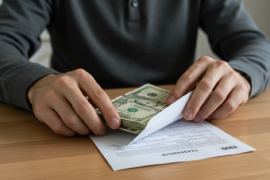This article may contain references to products or services from one or more of our advertisers or partners. We may receive compensation when you click on links to those products or services. Nonetheless, our opinions are our own.
You may have noticed it creeping in—an insidious feeling that extends beyond your work life and begins to overshadow your relationships. Burnout, once primarily associated with the nine-to-five grind, is starting to infiltrate time spent with loved ones, friends, and even family. You’ve probably felt the strain: the emotional fatigue, the sense of detachment, and the overwhelming urge to retreat from social interactions. What might start off as feeling overwhelmed at work can gradually seep into how you connect with those around you. We will explore how burnout manifests in personal relationships, its subtle yet profound effects, and practical steps you can take to reclaim the joy and connection that might feel lost right now. If you’re feeling pressed by life’s demands at work and home, you’re not alone—and there are ways to navigate this concerning shift.
-
Understanding Burnout Beyond the Workplace and Its Impact on Personal Connections
- Recognizing the Signs of Burnout in Your Relationships
- The Connection Between Emotional Exhaustion and Relationship Strain
- Practical Strategies to Combat Relationship Burnout Effectively
- Building a Supportive Environment to Foster Healthy Connections
- Taking Action: When to Seek Professional Help for Relationship Burnout
- Conclusion
- Frequently Asked Questions
- Recommended Reads
Understanding Burnout Beyond the Workplace and Its Impact on Personal Connections
When burnout extends beyond the office, it often manifests in the relationships that once brought you joy and fulfillment. You might feel emotionally drained, less patient with your loved ones, or increasingly withdrawn from social interactions. This profound exhaustion doesn’t discriminate; it creeps into friendships, family dynamics, and romantic partnerships, leaving you isolated and disconnected. Here are a few signs that burnout might be affecting your connections:
- Communication Breakdown: You may struggle to express your feelings or find it hard to listen to others. Conversations might begin to feel like a chore rather than an opportunity to connect.
- Increased Irritability: Little things might start to annoy you more than usual, leading to conflicts that can strain your bonds with those closest to you.
- Decreased Social Participation: You might withdraw from gatherings or activities you once loved, leading to feelings of guilt and further isolation.
Being aware of these signs is the first step toward addressing the issue. Acknowledging how burnout affects your relationships and considering small yet significant adjustments is crucial. Take time for self-care, communicate openly with your loved ones about your feelings, and explore opportunities for quality time that doesn’t feel overwhelming. This way, you can effectively mend connections that might fray at the edges.
Recognizing the Signs of Burnout in Your Relationships
When caught in the whirlwind of daily life, it can be easy to overlook the subtle signs of emotional fatigue creeping into your relationships. You might feel increasingly irritable, constantly on edge, and less patient with your partner or loved ones. The once-enjoyable moments can feel like chores, and engaging in conversations may seem more like a burden than a joy. Here are some common indicators that suggest your relationships may be suffering from burnout:
- Withdrawal: You may start withdrawing from friends and family, preferring solitude over social interactions.
- Reduced Communication: Simple exchanges become strained, and essential discussions are neglected, leading to misunderstandings.
- Increased Complaints: You might find yourself focusing more on the negative aspects of your relationships rather than appreciating the positives.
- Emotional Exhaustion: Feeling drained after spending time with loved ones can indicate a deeper issue.
Recognizing these signs early on can be a significant change. Talking openly with your partner about how you feel, without placing blame, can help both of you understand the source of the strain. Consider the following table to identify specific behaviors that may reflect deeper issues:
| Behavior | Possible Cause |
|---|---|
| Consistent criticism | Stress and unmet needs |
| Avoiding intimacy | Fear of vulnerability |
| Constantly distracted during conversations | Emotional disconnection |
By monitoring these behaviors and addressing them proactively, you can begin to re-establish a sense of connection and trust in your relationships. Remember, it’s vital to prioritize emotional well-being individually and as a couple.
The Connection Between Emotional Exhaustion and Relationship Strain
It’s easy to underestimate how emotional exhaustion can seep into your relationships, transforming the dynamics you once cherished. When you’re feeling drained, the small irritations that once barely registered can start to feel overwhelming. You may snap at your partner over trivial issues or withdraw from the intimacy you both enjoy. This strain often leads to a cycle; as you become more exhausted emotionally, you may pull away even more, leaving your partner feeling neglected or rejected.
Consider how your well-being impacts those closest to you. Recognizing this connection can be instrumental in breaking the cycle of burnout and emotional distance. Here are a few signs to watch for that might indicate you’re experiencing this kind of strain:
- Increased Irritability: Small annoyances become significant triggers.
- Withdrawal: You avoid meaningful interactions and seek solitude.
- Reduced Communication: Conversations become superficial or rare.
- Loss of Affection: Emotional or physical intimacy diminishes.
By acknowledging these signs and taking steps to address your emotional health, you can begin to mend the rifts forming in your relationships. This might mean prioritizing self-care or seeking support from loved ones or professionals. Whichever path you choose, remember that your emotional state affects not only you but also the loved ones who share your life.
Practical Strategies to Combat Relationship Burnout Effectively
When relationship burnout starts to creep in, implementing practical strategies can serve as a lifeline to breathe new energy into your connection. Consider setting aside dedicated time for meaningful conversations—not just about daily logistics or to-do lists, but about your feelings, aspirations, and insecurities. Creating a safe space for open dialogue can foster deeper emotional intimacy and reinforce your bond. Also, prioritize quality time over quantity; it’s not just about being together, but about being present. Engage in activities you both enjoy, nurture your shared interests, and explore new hobbies together to reignite that spark.
Another effective strategy is to practice gratitude—acknowledge the little things your partner does that make your life better. Keep a gratitude journal where both of you can jot down notes about what you appreciate in each other. This simple act can shift your focus from what feels burdensome to what brings joy. Additionally, don’t underestimate the power of self-care; taking time for yourself can replenish your energy and get you back to the relationship with renewed positivity. Remember, showing up whole and content as an individual often translates into a healthier partnership.
Building a Supportive Environment to Foster Healthy Connections
Creating an environment where healthy connections can thrive is essential, especially as the pressures of daily life start to seep into your relationships. Start by prioritizing open communication; it’s the bedrock of any supportive relationship. Make it a habit to share your feelings regularly, whether positive or negative. This practice encourages vulnerability and trust, paving the way for deeper connections. Consider scheduling regular check-ins with loved ones, allowing everyone a safe space to voice their concerns or celebrations.
Additionally, adopting a mindset of empathy can significantly enhance your interactions. Here are some ways to foster this environment:
- Active Listening: Focus entirely on what the other person is saying, acknowledging their feelings without interruption.
- Encouragement: Celebrate each other’s successes and provide reassurance during tough times.
- Shared Activities: Engage in common interests or new experiences to reinforce your bond.
| Action | Outcome |
|---|---|
| Open Communication | Builds trust |
| Empathetic Engagement | Fosters understanding |
| Shared Experiences | Strengthens connection |
Investing time and intent into your relationships not only combats feelings of isolation but also enriches your interactions, creating a network of support that can help ward off the effects of burnout.
Taking Action: When to Seek Professional Help for Relationship Burnout
Recognizing when to seek professional help is crucial in addressing relationship burnout. The first sign you may need extra support is when conversations become repetitive and arguments feel unresolvable. If there seems to be a persistent disconnect between you and your partner, it’s time to evaluate how long you’ve been feeling this way. Consider these factors:
- Communication Breakdown: If you’re finding it increasingly hard to communicate without arguing or feeling misunderstood, a therapist can provide strategies to improve your interactions.
- Emotional Exhaustion: When you feel drained by your relationship rather than energized, and the thought of connecting feels like a chore, professional guidance can show you how to rekindle that spark.
- Loss of Intimacy: A noticeable drop in physical or emotional intimacy can indicate deeper issues that require more than a heart-to-heart conversation.
- Recurring Patterns: If you notice cycles of conflict that you fail to break on your own, engaging a third party who can offer an objective perspective might be beneficial.
Finding the right time to seek help is a personal decision, but remember: asking for help isn’t a sign of weakness. As you would seek support for work-related burnout, prioritizing your relationship’s health is equally important. Engaging with a couples’ counselor or therapist can provide a safe space to work through your frustrations, facilitate better communication, and help you reconnect. You deserve a relationship that brings you joy and fulfillment.
Conclusion
Burnout doesn’t just affect your work life; it can slowly infiltrate your relationships, leaving you feeling disconnected, emotionally drained, and distant from the people you care about most. Recognizing the signs of relationship burnout early and taking proactive steps can help you rebuild the bonds that matter. By prioritizing open communication, self-care, and shared quality time, you can foster healthier connections and prevent burnout from taking over your life. Don’t hesitate to seek professional support if the emotional strain becomes overwhelming. Remember, taking care of your emotional well-being isn’t a sign of weakness—it’s a necessary step toward creating a balanced, fulfilling life, both at work and in your relationships. You deserve to feel connected, supported, and energized, and with the right approach, it’s possible to reclaim joy in both your personal and professional spheres.
Frequently Asked Questions
What are the signs that burnout is affecting my relationship?
Look for signs like increased irritability, withdrawal from shared activities, lack of emotional availability, and communication breakdowns. These may be red flags if you’re often too exhausted to engage with your partner or feel detached.
How can I differentiate between work burnout and relationship burnout?
While work burnout frequently manifests as chronic fatigue related to job demands, relationship burnout often presents as emotional exhaustion and disconnection with your partner. Take note if your dissatisfaction stems more from home life and connection than career stress.
What are some common causes of relationship burnout?
Relationship burnout can stem from prolonged stress, lack of healthy communication, unmet emotional needs, and unresolved conflict. External pressures, such as financial strain or family obligations, can exacerbate these challenges, making it tough to find time for connection.
How can I address relationship burnout?
Start by initiating open conversations with your partner about how you both feel. Prioritize your emotional well-being and set aside quality time to reconnect. Engaging in shared activities, practicing self-care, and seeking professional support like couples’ counseling can also be beneficial.
Is it possible for burnout in one partner to affect the other?
Absolutely. Emotional burnout can create a ripple effect. If one partner struggles, it can lead to misunderstandings and feelings of neglect for the other. It’s essential to recognize the interconnectedness of your emotional states and work together to support each other.

Reviewed and edited by Albert Fang.
See a typo or want to suggest an edit/revision to the content? Use the comment form below for feedback.
At FangWallet, we value editorial integrity and open collaboration in curating quality content for readers to enjoy. Much appreciated for the assist.
Did you like our article and find it insightful? We encourage sharing the article link with family and friends to benefit as well - better yet, sharing on social media. Thank you for the support! 🍉
Article Title: How to Overcome Relationship Burnout and Reignite Connection
https://fangwallet.com/2025/04/15/overcome-relationship-burnout/The FangWallet Promise
FangWallet is an editorially independent resource - founded on breaking down challenging financial concepts for anyone to understand since 2014. While we adhere to editorial integrity, note that this post may contain references to products from our partners.
The FangWallet promise is always to have your best interest in mind and be transparent and honest about the financial picture.
Become an Insider
Editorial Disclaimer: The editorial content on this page is not provided by any of the companies mentioned. The opinions expressed here are the author's alone.
The content of this website is for informational purposes only and does not represent investment advice, or an offer or solicitation to buy or sell any security, investment, or product. Investors are encouraged to do their own due diligence, and, if necessary, consult professional advising before making any investment decisions. Investing involves a high degree of risk, and financial losses may occur including the potential loss of principal.
Source Citation References:
+ Inspo
Investopedia. (n.d.). Investopedia. https://www.investopedia.com/
Wikipedia, the free encyclopedia. (n.d.). https://www.wikipedia.org/
Fang, A. (n.d.). FangWallet — Personal Finance Blog on Passive Income Ideas. FangWallet. https://fangwallet.com/
Google Scholar. (n.d.). Google Scholar. https://scholar.google.com/
There are no additional citations or references to note for this article at this time.











































